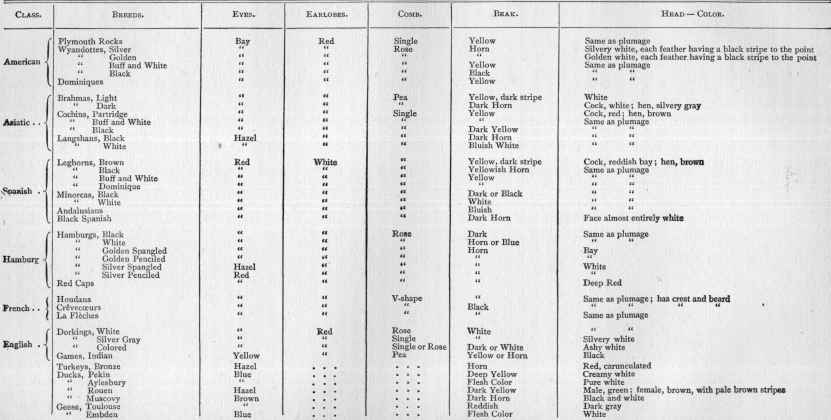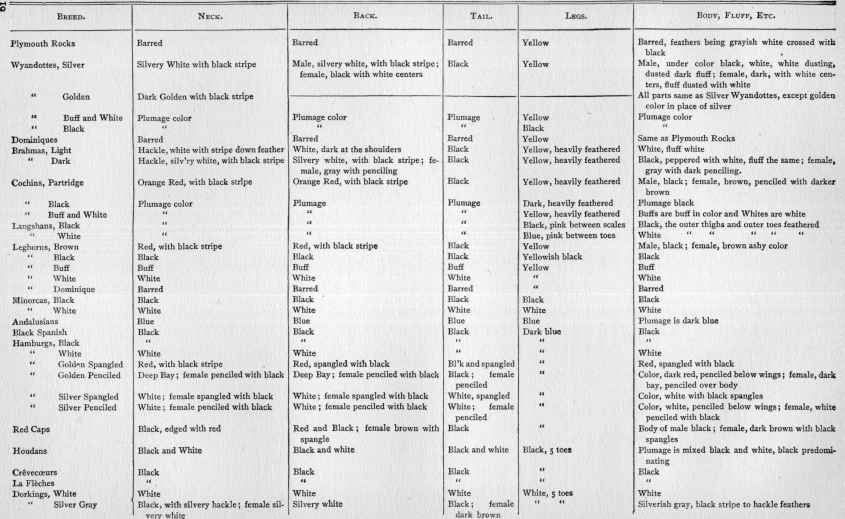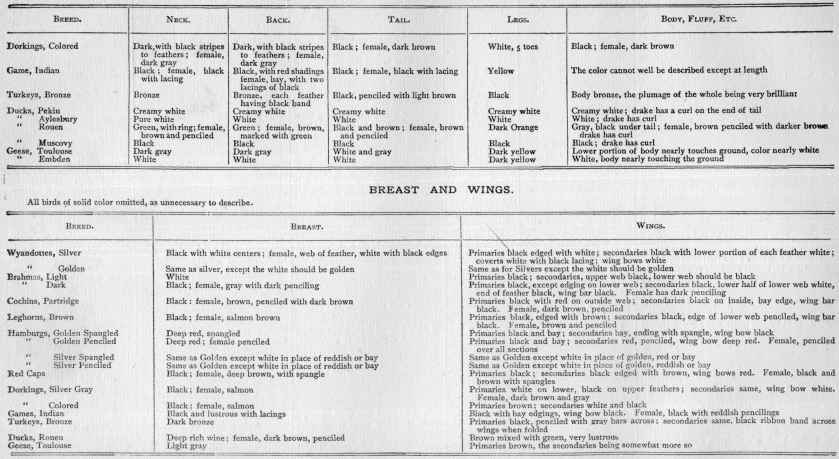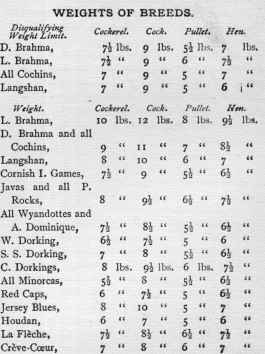DESCRIPTION OF BREEDS.
HEAD, COMB, EAR-LOBES, AND BEAK.
In this description we use only the well-known breeds. Polish, Silkies, the different show Games, and other useless varieties that are ornamental, are omitted for the reason that they could not be sufficiently
described here.
 NOTES ON THE ABOVE.
Combs of Leghorns and Plymouth Rocks should have 5 or 6 points (5 preferred). Spike on comb of Wyandottes should curve down, fitting the skull; spikes of Hamburgs should curve upward. Pyle Leg.
horns are omitted. Ear-lobes of Silvery Gray and Colored Dorkings should be red; but red is not imperative, as Dorkings are allowed mora latitude than other breeds. Bronze Turkeys differ from Narragansetts ia
being bronze, the Narragansetts being black. Minorca combs should be large. Rose-comb Leghorns differ from the others only in having rose combs.
NECK, BACK, BODY, TAIL, LEGS, ETC.

DESCRIPTION OF BREEDS. — Continued.
 There are also disqualifications. For instance, a clean leg fowl should have no feathers on shanks, while absence of feathers on Asiatics (Brahmas, Cochins and Langshans) disqualifies. Brahmas and Cochins
should have heavy middle toe feathering, the feathers on outer toe reaching to the end. Langshans need not have middle toe feathering. It is impossible to fully describe all the breeds. Campines, Javas, Sumatras,
and such like are rare. Single comb birds are disqualified if they have rose combs, and vice versa. Combs must be free of side sprigs. The Dominique has long, flowing sickles, thus differing from the Plymouth
Rock. Many birds are described at length in separate articles.
POULTRY. 291
In view of this we give a table, showing the dif
ferent breeds, the characteristics of each, and how
they should be, if perfect; also a table showing how
birds are scored. No bird can score over one hun
dred points, as one hundred is supposed to be ideal.
The points are these:
Symmetry................8
Weight.................6
Condition ................6
Head, Shape 3; Color 3...........6
Comb, Shape...............8
Wattles and Ear-lobes............6
Neck, Shape 4; Color 6...........10
Back, Shape 4; Color 4 ...........8
Breast, Shape 5; Color 5...........10
Body of Fluff, Shape 5; Color 3........8
Wings, Shape 4; Color 4. ..........8
Tail, Shape 4; Color 4............8
Legs and Toes ..............8
100
How to Cut in Judging.—Mr. Isaac K. Felch, in
his book “ Philosophy of Judging,” in explaining
the “cuts,” selects Light Brahmas, and describes
how much to cut for “ condition " and for “ form," in
sections. It will be noticed that he cuts from half
a point up.
Cuts for Condition.—Too fat or too lean . ˝ to 2
Weeping eye......... I
Distemper ...... . .. . 1
Roughness of shank....... ˝ to 3
Uncleanliness......... ˝ to 2
Cuts for Form. Comb.—Crooked middle
section.......... 1
All three sections crooked..... i to 3
Too large.......... ˝ to 1˝
Head.—Narrowness of skull...... ˝ to 1
Very small wattles....... 2
Very large wattles....... ˝ to I
Lack of throat in hen...... I
Neck.—Too long......... ˝
Too short.......... ˝
Too straight......... I
Scanty hackle, causing slim neck ... ˝ to I
Too long and flowing hackle .... ˝
Back.—Too straight or roached .... ˝ to 1˝
Narrow in front of tail...... ˝ to 1
Convex saddle......... ˝ to 1
Breast.—Flatness......... ˝ to 2
Lack of forward sweep...... 1
Body.—Flatness of sides and narrowness of
fluff...........˝ to 1
Wings.—Twisted feathers...... 1 to 2
Imperfect folding........ ˝ to 1˝
TAIL.—Carried too high ....... ˝ to 1
Carried too low........ ˝ to I
Close and pinched....... I to 1˝
Spread too much........ ˝
Straight sickles......... 1
Legs and Feet.—Approach to vulture
hock........... ˝ to 2
Shanks too short ........ ˝
Shanks too long........ ˝ to 1˝
Knock-kneed......... ˝ to 3
Too light leg feathering . . . . . . ˝ to 1
Bare outer toe ......... I˝
Bare middle toe........ I
Cuts for Color. Neck.—Want of striping
in hackle.......... ˝ to 3˝
Faded color in stripes...... ˝ to 2
Smutty lacing........ . ˝ to 2
Solid black for two inches from point . 1˝
Faded stripe in hen's hackle . . . . ˝ to 3
Back.—Gray or slaty shading on surface . . ˝ to I
Black ticks over shell bone..... ˝
Black ticks extending across the back to
hackle..........Disqualify
Dark slate spots in back of female . . ˝ to 1˝
Yellow tinge......... ˝ to 1˝
Wings.—White in primaries of male ... ˝ to 3
White in upper edge of secondaries (male”), ˝ to 3
Yellow tinge on coverts...... I to 1˝
Primaries of females, more than one-half
white........... ˝ to 2
Secondaries of females, more than one-
half white......... ˝ to 2
Tail.—White in sickles two inches from
body........... I
White in sickles above coverlets . . . I to 1˝
White coverlets....... . I
White on main tail feathers .... I
White tips on main tail feathers ... I
White coverlets on female..... 1
White main tail feathers third length . . I to 1˝
White tips, main tail feathers “Cotton-
tail” ........... I to 2˝
Legs and Feet.—Pale straw color on hen's
shank.......... ˝

292
THE FRIEND OF ALL
Classification of Breeds.—The breeds that are
divided into varieties of different colors vary only
in the difference of plumage, all being equal as lay
ers, etc.
American Class.—Plymouth Rocks.—Barred,
Buff and White. The Javas (Black, Mottled and
White) are really about the same as Plymouth
Rocks except in a few minor exterior points.
Wyandottes.—Silver, Golden,White, Buff, Black.
The American Dominiques, White Wonder and
Jersey Blues also belong to the American class.
Asiatic Class.—Brahmas.—Light, Dark.
Cochins.—Buff, Partridge, White and Black.
Langshans.—Black, White.
All Asiatics have feathered legs, the Langshans
not quite so much as the Cochins and Brahmas.
The White Langshans are not regarded by some
as very hearty, but the Blacks are excellent birds
in every respect.
Mediterranean Class.—Leghorns.—Brown, White,
Buff, Dominiques, Black, Silver Duckwing, Red
Pyle. The Duckwing and Pyle are bred only as
novelties, and are rare. There are also Rose-comb
Browns and also of Whites, differing from other
Leghorns only in having rose-combs.
Minorcas.—Black, White. There are also rose-
comb varieties.
Andalusians.—Blue (really Blue Minorcas).
Spanish.—White-face Black. All of the Medi
terranean class are non-sitters, and lay eggs that are
white in color of shell.
Polish and Hamburg Class.—Hamburgs.—White,
Black, Golden Penciled, Silver Penciled, Golden
Spangled and Silver Spangled.
Polish.—Golden, Silver White, White-crested
Black, Buff-laced, Bearded Golden, Bearded Silver
and Bearded White.
Hamburgs and Polish are non-sitters, the eggs
are white, and the Polish are more ornamental than
useful. To the Hamburg class belong Red Caps
and Campines, breeds that are not generally bred,
as they lack in hardiness in this country.
French Class.—Houdans, Crčve-cśurs and La
Flčches compose the French class. They are non-
sitters and excellent table fowls, but are not good
winter layers as a rule.
English Class.—Dorkings.—White, Silver Gray
and Colored. Dorkings are not prolific layers, but
excel as sitters and for the table.
Came Class.—The Indian Game is the only one
bred for utility. There are quite a lot of “ fancy “
Games, such as Black-breasted Reds, Brown Reds,
Golden Duckwing, Silver Duckwing, Red Pyle,
White, Black and Birchen. The Game Bantams
correspond except as to size. Pit Games have no
descriptions, as they may be of any color or size.
It would require a large book to describe all the
Games. All Games are sitters, and the eggs are
nearly white in color.
Bantam Class.—Bantams comprise all the Game
varieties to correspond with the large Games.
There are also the following Bantams :
Cochins.—Buff, Partridge, White and Black.
The class includes, other than Cochins, the Japa-
nese, Polish, Booted White, Rose-comb Black,
Rose-comb White, Golden Sebright, and Silver
Sebright.
Miscellaneous Class.—This includes the Suina-
tras, Russians, Frizzles, Rumpless, Suttans and
Silkies, which are bred only as novelties.
Sitters and Non-Sitters.—Of the above the Asi
atic, American, English, Game, Bantam ahd Mis
cellaneous classes comprise sitters (except Polish
Bantams), all other classes comprising non-sitters.
All non-sitters lay eggs with very white shed.
Before the Show.—Begin six weeks ahead of time.
Oil the legs, combs, wattles and beak with a gill of
lard oil and teaspoonful of oil of pennyroyal. This
will clean the legs. About two weeks before, feed
sunflower seed at least twice a week. Wash the
comb, wattles and legs with one part alcohol, two
parts water.
About two days before you ship the birds it is
well to wash them. This is done by heating a room
up to about 100 degrees ; then fill a tub half full of
warm water, make a lather of castile soap, and put
the male in first and wash him well, lightly at first,
then harder as he needs it. Do not fear that the
feathers will break, as when wet they will not.
Wash from head to tail. When the dirt or stains
are gone, place the bird in the rinsing-tub, which,
by the way, should have a little cooler water than
the first. When rinsed, place the bird in the
coops which have been placed around a stove, and
keep the temperature high.
When the birds begin to dry they will fluff up
their feathers, and each will dry and assume its
proper place. As the birds dry, let the fire die
down, so as to have as little change in temperature
as possible.
Pluck any false feathers before you ship. Also,
before you ship moisten the comb with glycerine to
keep them from freezing on the road to the show.
At the show, wipe off the glycerine after properly
arranging them, get all the niceties you can for them.
On the day of judging sponge their comb, head, wat
tles, etc., with alcohol half, and water half. Then
apply oil of pennyroyal to beak, legs and toes, and
wipe dry ; if necessary to remove, scour with a brush.
For success in keeping poultry, four things are
well to know: how to select the breed best adapted
to your special desire, how to feed the fowls, what
cleanliness is, and how to house the birds well.
Diseases of Poultry.—Dirt is a common cause of
sickness ; a damp location for your poultry-house is
another cause, and improper drainage is very bad.
All advise against a drafty hen-house, though do
not have a stuffy house.
POULTRY. 293
Don't let lice get in your houses.
A bad thing is to confine your birds, as it causes
weak legs. Overfeeding is as bad as to underfeed.
Don't give impure food or water.
It is always cheaper and easier to prevent disease
than to cure it. Avoid dampness, keep clean, nice
dry earth in your houses. Keep whitewashed and
well kerosened. Take out sickly fowls. Give good
space to all fowls, and don't overcrowd. Have
spare room for sickly ones.
A good mixture for fowls is one pound of cop
peras dissolved in two gallons of water, adding one
ounce of sulphuric acid. Keep in a corked jug, and
give to fowls and chickens twice a week, one table-
spoonful to a quart of water. It is sometimes best
to get rid of the bird which is sick rather than try
to cure it, especially if the disease is well set.
Chicken Cholera.—Cholera can be easily discov
ered by the fact, that the bird is excessively thirsty,
has a slow staggering gait and a drowsy look. Then
there is a diarrhea with a greenish discharge. The
quickest and best way to cure this disease is to kill
the bird lest the contagion spread. Bury the body
deep, and go to work and disinfect your houses and
yards. Do this by burning sulphur and alcohol,
one pound of sulphur to a pint of alcohol. After
this whitewash your house with lime. Put lime in
your yards after cleaning it up thoroughly.
If you wish to save the bird the remedies are ˝
teaspoonful of castor-oil; feed warm cooked food,
especially corn-meal worked into dough. After this
give boiled milk with a little red pepper. Another
remedy, powdered chalk, powdered charcoal, gum
camphor and pure carbolic acid, and assafetida; mix
equal parts, and give twice a day in food, one tea-
spoonful to ten fowls.
Diarrhea.—This is caused in fowls by the giving
of too much green food, dirty quarters or unclean
food. To cure, change their diet, give a pill of
cayenne pepper, rhubarb, and powdered chalk,
equal parts, and roll into a pill, wetting with cam
phor enough to moisten it.
Chickens ought to be kept warm, and should be
fed on boiled rice, boiled milk and warm foods. If
not cured in a few days give the pill mentioned for
fowls.
Constipation.—Caused by too close confinement,
or by being indoors. Give to chicks ˝ teaspoonful
of castor-oil and green food, and to fowls give one
teaspoonful of castor-oil; also give green food and
oyster-shells.
Roup.—This prevalent disease is simply an aggra
vated cold in the head. The symptoms are sneez
ing, hoarseness, watery eyes and a little watery
discharge from the nostrils. The head later be-
comes swollen, and canker comes in the throat.
First, remove the fowl to a warm place. Sponge
head with vinegar, and water equal parts. Give ˝
teaspoonful of castor-oil. Another good remedy is
a teaspoonful of lard, ˝ teaspoonful of pepper, mus
tard, and ginger, and mix with powdered rice into
a pill, and give each fowl one. Then add bromide
of potassium to the water for the whole of the fowls,
about 1˝ grains for each bird.
Gapes.—This disease is caused by a small worm
getting into the throat. The disease can be recog
nized by the fowl continually gasping for breath, or
by trying to clean the throat. One way of curing is
this : put the chick or fowl in a slatted box, invert it,
and raise it a bit from the floor. Put a hot coal under
it, but not red hot, and drop some carbolic acid on it,
allowing the fumes to rise until the bird chokes and
sneezes. Do not, however, let them choke to death.
This will make the worms loose their grasp, and the
bird can thus get rid of them.
Another good method is to put the fowls in a
box, and drop in some powdered air-slack lime, so
that the fine particles of lime will sift down among
the chickens. The lime is thus inhaled by the
fowls ; coughing is the result, thereby expelling the
worms. Another remedy is to run a feather down
the chicken‘s throat, pulling it back and forth, thus
loosening the worms.
Lice.—These are more easily prevented than got
ten rid of. Lice are liable to come from the setting
hen. When a hen is set, dust her with insect pow
der, keeping it out of her eyes, and about two or
three days before the chickens are hatched dust
her again. If, however, lice take possession of the
hen-houses remove all the earth from the floor,
wash the entire house thoroughly with kerosene and
whitewash, being sure that the latter fills every crev-
ice, put new earth on the floor, and make new
nest boxes.
Scaly Legs.—This disease is due to small insects
which burrow under the scales of the legs. They
cause rough and scurvy legs ; and this, being conta
gious, should be promptly attended to. The legs
should be washed in carbolic soap-suds. Another
remedy is a preparation of sulphur and lard, which
is to be rubbed on, after which, dip the legs in kero-
sene-oil for a sufficient length of time for the oil to
penetrate the scabs. Also wipe the roosts with
kerosene-oil.
Molting.—During molting, which is a natural ac
tion and not a disease, it is best to feed the hens
good nutritious food, and keep them too fat rather
than too lean, expecting no eggs.
Feather-Eating.—This is a very harmful habit;
and its causes are idleness, lack of animal food and
green stuff. The only cure is forced exercise,
which can be accomplished by covering the floor
with straw, throwing grain amongst it, thus making
them scratch for their living. Also give them plenty
of green food.
Crop-Bound.—This disease is found when the
crop is hard and swollen to twice its natural size,
and is caused by the inability of the hen to pass
OF ALL.
But first, if you want to come back to this web site again, just add it to your bookmarks or favorites now! Then you'll find it easy!
Also, please consider sharing our helpful website with your online friends.
|





